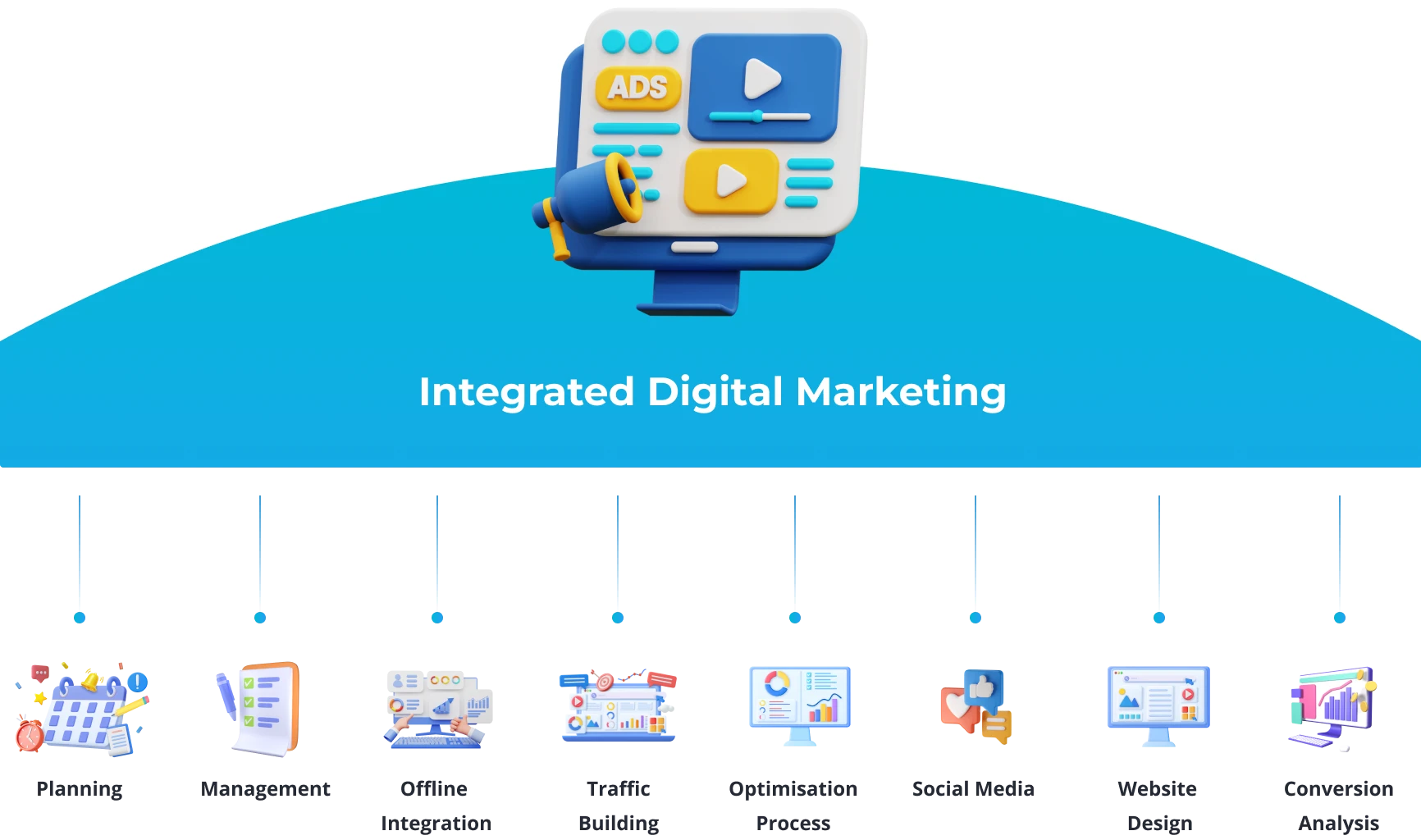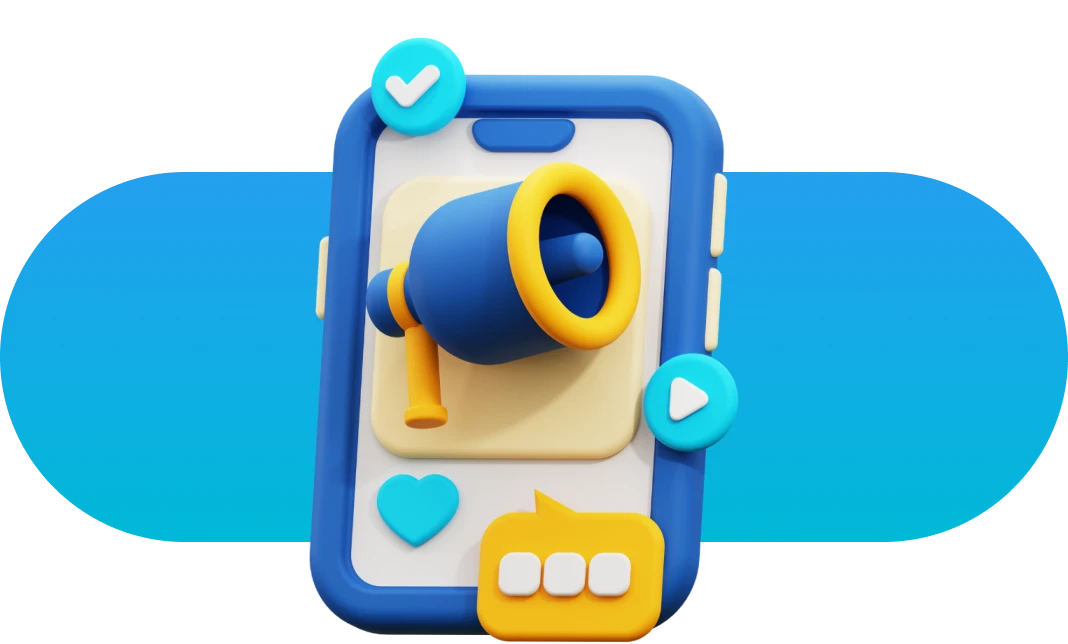If you feel like every click, like, and share is single-handedly shaping the success of your business, but you’re unsure how to organise your marketing efforts into a cohesive plan, this beginner’s guide to Integrated Digital Marketing is for you.
Integrated Digital Marketing (IDM) is a framework that helps businesses to streamline their digital marketing and maximise results across various digital channels. It’s the masterplan that ensures the strategies for each of your marketing channels are coordinated, and your communication and messaging are cohesive no matter where your customers interact with you online.
In this guide, we introduce IDM and the types of IDM strategies, show you an example of a separate vs. integrated approach for an E-Commerce brand, and break down how to develop an integrated strategy for your small business.

At Five by Five, we’re all about helping you share your magic through great looking, high performing websites. Whether you’re a new business in need of a wow-worthy digital launch, or an established business looking to refresh and replace your old site, we have the know-how and dedication to make it happen. Contact us today to get started.
What is Integrated Digital Marketing?
Integrated Digital Marketing is a holistic marketing approach designed to create a unified and cohesive brand experience for customers. Unlike traditional marketing methods that operate in isolation, IDM helps you build a comprehensive marketing plan that keeps your strategies aligned across your selected digital channels.
IDM goes beyond the boundaries of individual channels like social media, email marketing, SEO, content marketing, and paid advertising. Businesses can orchestrate their marketing efforts in a synchronised manner, and enhancing brand visibility, engagement, and conversion rates across the board.
Types of Integrated Digital Marketing Strategies
Content-centric approach
A content-centric approach to IDM revolves around the creation and distribution of valuable, relevant content tailored to different stages of the customer journey. By crafting compelling articles, blog posts, videos, and other forms of content, businesses can engage and nurture leads throughout their purchasing process. This content is then strategically amplified across various digital channels to maximise reach and impact.
For example, a small business owner that discovers Five by Five on Instagram might visit our website and download our free SEO Audit Checklist. Joining our email list, they receive a series of nurture emails over the following few weeks, each designed to introduce them to our agency, provide additional tools and resources, and showcase how we can help them achieve their business growth goals.
Data-driven strategy
With a data-driven integrated digital marketing (IDM) strategy, businesses use analytics and insights to learn more about what their audience likes, where they spend their time, and what they struggle with. Understanding this information helps businesses to identify trends, behaviour patterns, and opportunities to better connect with their audience – and, importantly, to tailor their marketing accordingly. This might look like:
- A local yoga and pilates studio segmenting their online audience based on member interests or attendance patterns, and personalising their email marketing to provide more relevant and intentional content to their community.
- An e-commerce brand conducting a consumer behaviour analysis to assess how customers interact with their website, and optimising for a better user experience to increase shopping cart conversions.
- An activewear label analysing social media engagement to see which types of content resonate most with their audience, and adjusting their content strategy to include more of what their audience responds to.
The best part of a data-driven approach? It shows in the numbers, with clear, measurable results!
Cross-channel coordination
Cross-channel coordination lies at the heart of IDM, ensuring seamless communication and alignment across all digital touchpoints. By synchronising messaging, branding, and promotions across channels such as social media, email, website, and mobile apps, businesses can provide a consistent and cohesive brand experience to customers, regardless of the platform they engage with.
An example of how we do this at Five by Five is creating educational and topical long-form content pieces (eg. blog posts, downloadable PDFs and webinars). We share these content pieces to our email database via our monthly Digital Dose newsletter. We also create social media posts to provide valuable content to our Instagram and LinkedIn communities, while driving traffic to our website at the same time.
This integrated approach means each of our digital channels supports the others, guiding our audience through a seamless and intuitive customer journey.

Example of Integrated Digital Marketing
Keeping those approaches in mind, let’s look at an integrated digital marketing strategy at play. We’ll use an E-Commerce Fashion Brand as an example, and consider what their marketing efforts of this brand might look like if they were pursued in isolation (or siloes), without any integration or coordination.
Siloed approach: Struggling with a poor marketing strategy
On social media, the brand runs separate influencer campaigns, social media ads, and organic content initiatives without alignment or a common purpose. While each initiative may generate some engagement and visibility, the lack of cohesion and consistency dilutes the brand’s messaging and fails to create a unified brand experience for its audience. Instead, their social media presence may seem disjointed and disorganised, leaving viewers unsure of the product offering, point of difference, or why they should buy.
Similarly, the brand sends out generic email blasts to its entire subscriber list, offering limited personalisation or segmentation. As a result, many recipients may disregard these emails or mark them as spam, diminishing the brand’s credibility and trustworthiness. Without tailored content or targeted messaging, the brand misses out on opportunities to drive conversions and nurture customer relationships through email marketing.
On the website, updates are infrequent, and the user experience lacks polish or attention to detail. Visitors may encounter broken links, slow loading times, or outdated product information, leading to frustration and abandonment. Without a cohesive design strategy or Search Engine Optimisation, the website fails to effectively showcase the brand’s products and convert visitors into customers.
This siloed approach results in fragmented messaging and disjointed customer experiences. Without a unified strategy guiding their digital marketing efforts, the e-commerce fashion brand struggles to differentiate itself, attract new customers, and generate sales.
Integrated approach: Executing an effective marketing strategy
So, how could this E-Commerce Fashion Brand implement an integrated digital marketing strategy to coordinate their marketing efforts more effectively?
The brand recognises the importance of using multiple digital channels to reach fashion-conscious consumers and convert them into paying customers. By integrating their marketing efforts across social media, influencer partnerships, and email marketing, the brand creates a seamless brand experience that connects with its target audience and builds both brand consideration and loyalty.
On Instagram and TikTok, the fashion brand collaborates with influencers to showcase its latest collections and highlight key trends. These partnerships not only increase brand visibility but also lend credibility and authenticity to the brand’s offerings, particularly among younger audiences.
At the same time, the brand runs targeted social media advertising campaigns to reach potential customers who align with its target audience profiles. Using data analytics and audience insights, the brand identifies relevant demographics, interests, and behaviours to optimise ad targeting and maximise return on advertising spend.
The brand encourages their social media followers to join an exclusive VIP List, and communicates regularly with this audience through email marketing. Subscribers receive personalised emails featuring exclusive discounts, product recommendations, and styling tips based on their browsing and purchase history. By tailoring content to individual preferences and behaviours, the brand strengthens customer relationships and encourages repeat purchases.
On their e-commerce website, the brand provides a seamless shopping experience with user-friendly navigation, high-quality product imagery, and detailed product descriptions. Visitors can easily browse through the latest collections, add items to their cart, and complete transactions with confidence, thanks to secure payment gateways and hassle-free returns policies.
This integrated approach strategically drives traffic to the brand’s online store – optimised to convert visitors into paying customers – while also fostering brand loyalty and advocacy among its customer base. By maintaining consistency in messaging and branding across social media, influencer partnerships, email marketing, and website channels, the fashion brand creates a cohesive brand narrative that resonates with its audience and distinguishes it from competitors.

How to develop an Integrated Digital Marketing strategy for your small business
Define your goals
Begin by clearly defining your business objectives and identifying key performance indicators (KPIs) to measure success. Whether it’s increasing brand awareness, generating leads, driving website traffic or boosting sales, having specific and measurable goals will guide your IDM efforts and ensure alignment with your overall business strategy.
Understand your audience
Invest time in conducting market research to gain a deep understanding of your target audience’s demographics, preferences, behaviours, and pain points. By segmenting your audience and creating buyer personas, you can tailor your marketing messages and content to resonate with specific audience segments, ultimately driving engagement and conversion.
Choose the right channels
Once you understand your audience (particularly how they spend their time and where), it’s crucial that you strategically select the digital channels that align with your audience’s preferences and behaviours. You want to meet your audience where they are. Our favourite example of this is Lamborghini’s iconic statement: “We don’t do commercials because our target audience isn’t sitting around watching TV”.
Whether it’s social media, email marketing, organic search, paid advertising, or more traditional styles of print media, prioritise channels that offer the greatest potential for reaching and connecting with your target audience.
Create consistent brand messaging
Develop a cohesive brand voice and messaging strategy that reflects your brand values, personality, and positioning. Your visual branding, key messaging (ie. what you do, why you do it, and why customers should buy from you), and tone of voice should be consistent across all digital touchpoints to reinforce brand recognition and foster trust and loyalty among your audience.
Monitor and adapt
Continuously monitor the performance of your IDM efforts using analytics tools and platforms. Track key metrics such as website traffic, engagement rates, conversion rates, and ROI to gauge the effectiveness of your campaigns and initiatives. Based on data insights and feedback, iterate and optimise your strategy over time, making adjustments to messaging, targeting, and channel selection to maximise results and drive continuous improvement.
As a small business owner, using an Integrated Digital Marketing framework to organise and execute your digital marketing strategies is one of the best ways to minimise overwhelm and maximise your impact. Navigating the complexities of modern marketing can be frustrating and draining, especially if you’re the one wearing all the hats in your business with little to no time for it.
If you’re unsure where to start, or still feel overwhelmed by the moving parts of an effective integrated strategy, you don’t need to do it alone. As experts in web design and strategic marketing, we’re here to be your digital partner and help your business succeed. If you’d like to learn more, complete our website briefing form or contact us online and we can get you set up for success.





